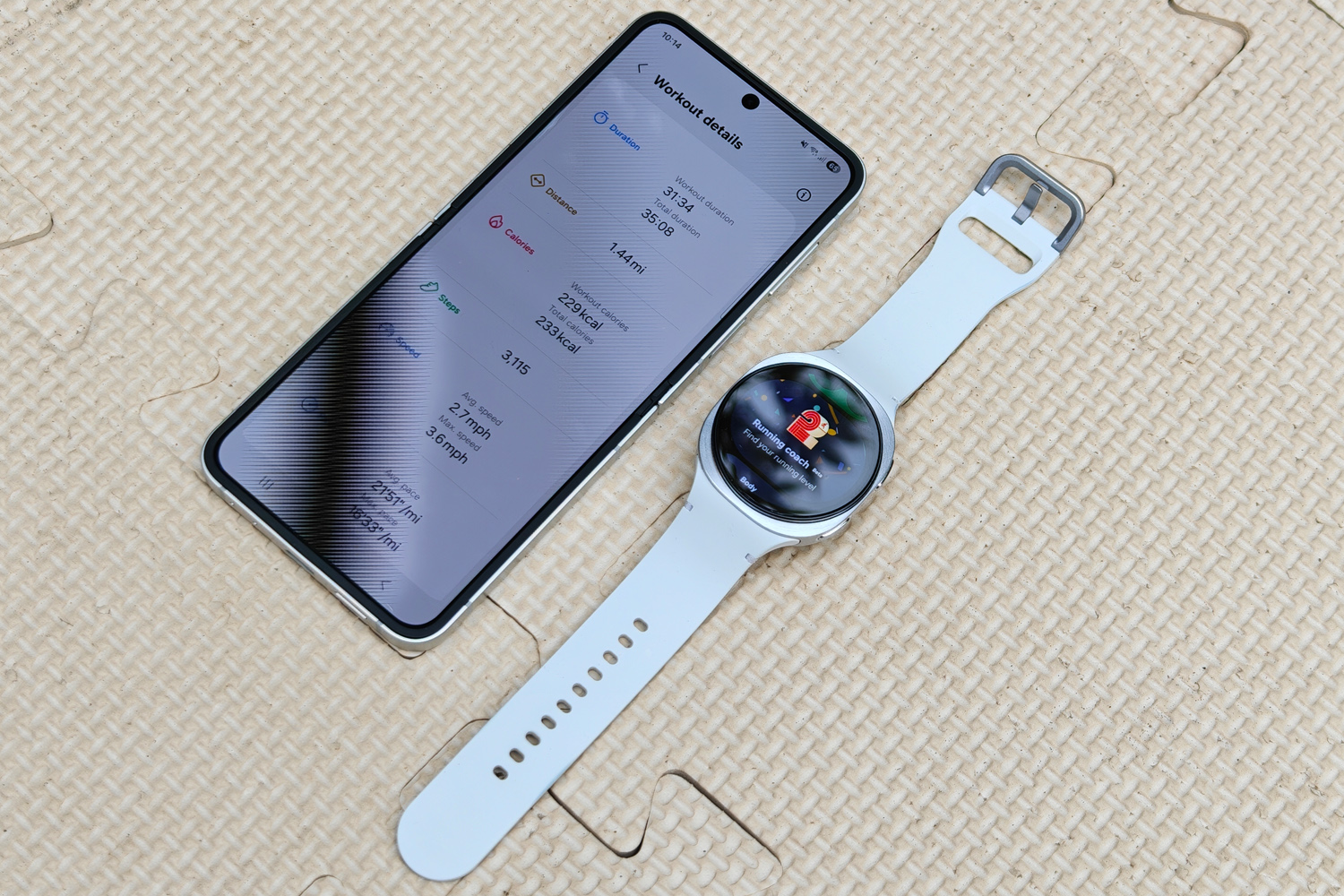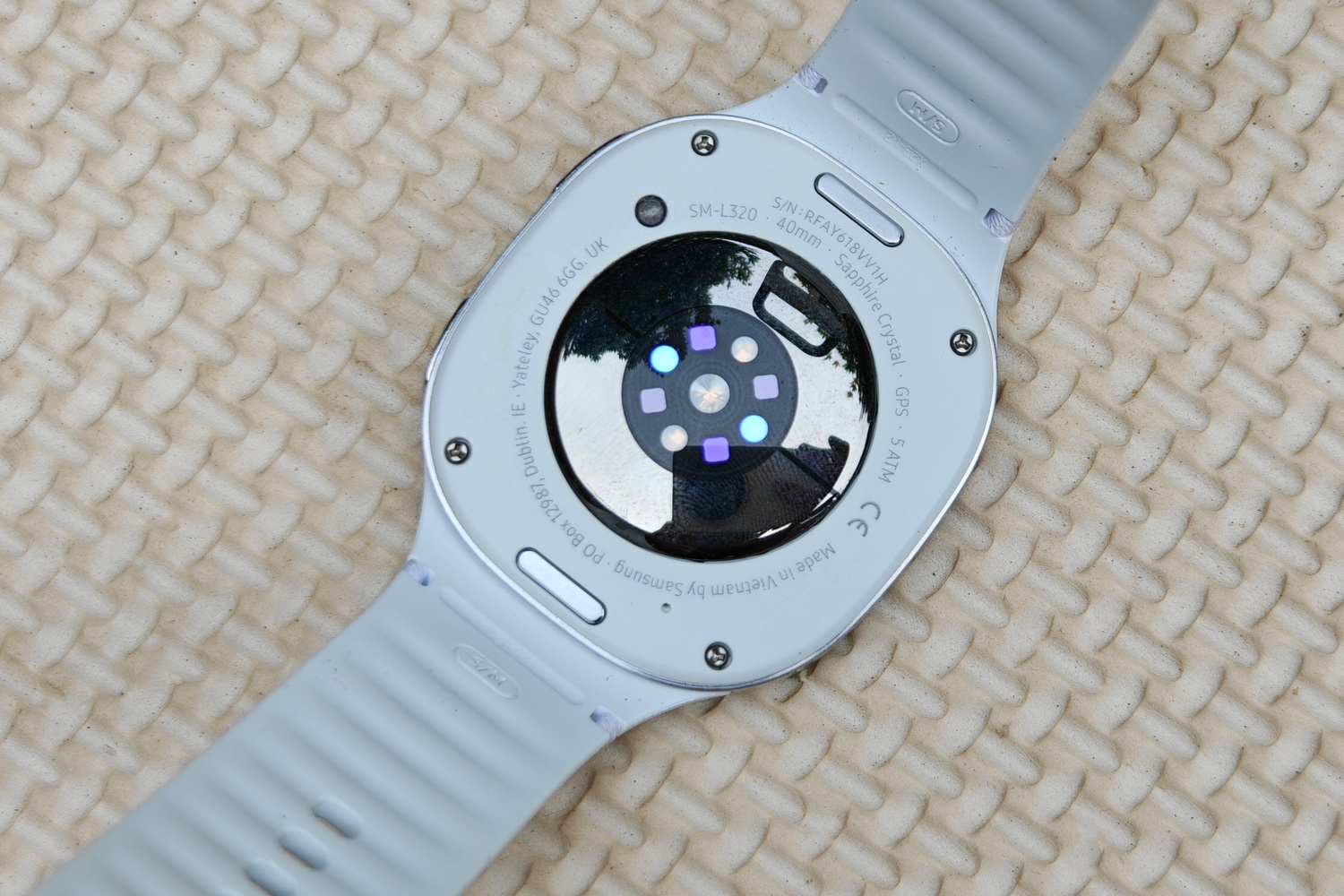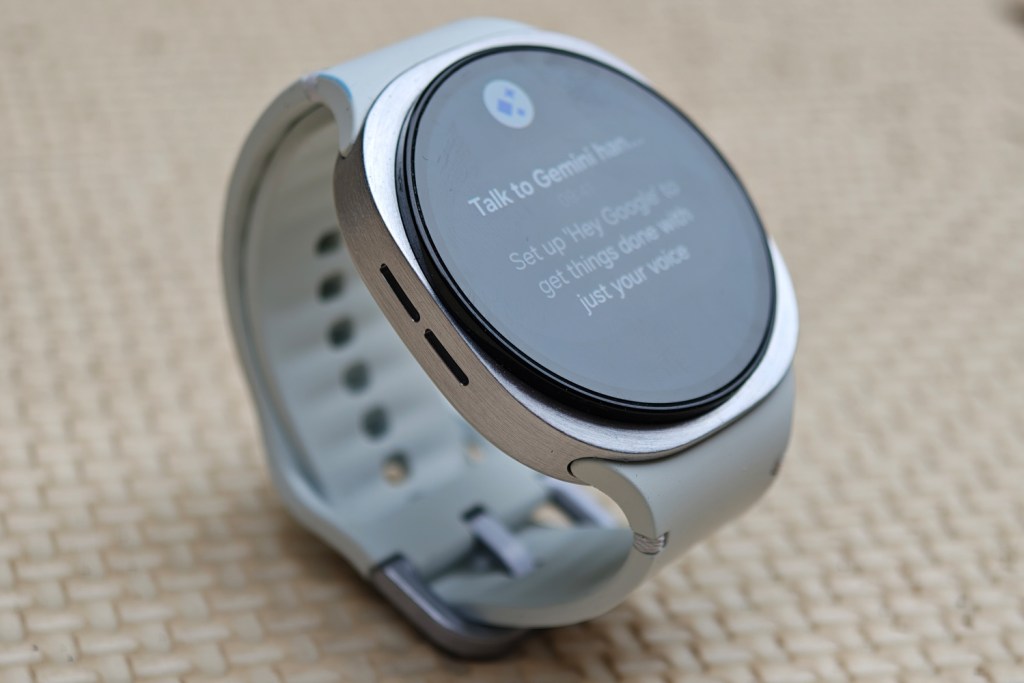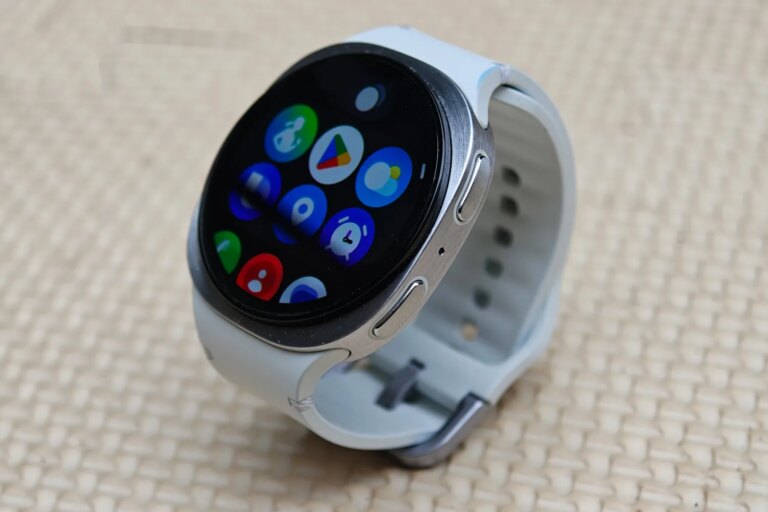Introduction
This year’s mainstream Galaxy Watch puts an even more minimal twist on Samsung’s usual wearable formula. A sensible move given its smartwatch bigger brother has gone in the other direction, with a thick rotating bezel set in an equally chunky case. Now there’s something for everyone, whether they want their wrist wear to command attention or prefer it to slip into the background.
Unlike the singularly-sized Galaxy Watch 8 Classic, you get two options here: 40mm and 44mm, each in Wi-Fi-only or LTE flavours. The latter size finds room inside for a bigger battery, but they’re otherwise identical. Same processor, same health sensors, same software experience. Picking between them boils down to how much of your wrist you want it to swallow up – and how much you’re willing to pay.
The Galaxy Watch 8 starts at $349/£319, but climbs to $429/£399 – not too shy of the $499/£449 Watch 8 Classic, and more than pretty much every other Android wearable – including the excellent OnePlus Watch 3, which set the battery life standard when it landed at the start of 2025. Can Samsung do enough to become the go-to smartwatch for most Android owners?
Design & build: simple is best
The sleek and subtle Galaxy Watch 8 is a world away from the bold Watch 8 Classic and its chunky coin-edge bezel, though there is a family connection. Samsung has rolled out the cushion-style case out across its 2025 line-up, for a more distinctive appearance than the circular design seen on the outgoing Galaxy Watch 7. The circular screen – which has no outer bezel – protrudes up from the case. It looks great, especially when paired with a minimalist watch face.
You just get two buttons at the side of the Watch, sitting almost flush to the case. I wish Samsung had made the new three button layout – which first appeared on the Galaxy Watch Ultra, and is now also found on the Watch 8 Classic – standard, though. It’s just so convenient for getting straight to a specific workout mode. Regular gym goers can at least reassign a double-press of the top button here, so it goes to the exercise screen instead of returning to your last-used app.
A new mounting mechanism sees the straps blend almost seamlessly into the watch body, and brings the heart rate sensor that little bit closer to your wrist than before to boost its accuracy. I did find it rather fiddly to clip the included polymer band into place, though, and you can’t snap generic 22mm bands on like you could with the previous generation.
There’s not a faux stitch in sight on the regular Watch 8’s bundled sport band; just a few strands of nylon fabric to liven up the otherwise plain rubber. Matching colours mean you’ve got to look closely to spot them; I preferred the Galaxy Watch 7’s contrasting material.
If you plan to swap straps on the regular, maybe go for the Silver Galaxy Watch 8 over the Graphite version. The casing is a better match for Samsung’s official strap selection, which are mostly lighter colours.
Screen: bigger is better?
My 40mm review unit might be the smallest Galaxy Watch 8, but its 1.3in circular AMOLED display is essentially on par with the one found on the Watch 8 Classic, which needs to leave room for its rotating bezel. If you want to go big, the 44mm Watch 8 and its 1.5in screen are your best bet. It has a higher resolution, too.
With no outer bezel here, it’s more obvious where the display panel ends and the outer frame begins. It’s worth experimenting with different watch faces; some minimise the black bar more effectively than others. It being an OLED means blacks are truly black, meaning the always-on display mode can be particularly effective – as long as you’re happy with it sapping more battery life than if you stick with raise-to-wake. Colours are suitably punchy and viewing angles are exceptional, too.
Outdoor visibility is fantastic, thanks to a 3000 nit peak brightness. This is a welcome jump over the previous Galaxy Watch, and the fast-acting ambient light sensor meant it never scorched my retinas when stepping out of direct sunlight.
I was a little concerned the exposed glass would be more susceptible to knocks and scratches, but so far I’ve had no issues. The sapphire crystal face is pretty sturdy.
Interface: enter Gemini
On the inside, the Watch 8 and Watch 8 Classic are almost a dead heat: same Exynos 1000 CPU, same comprehensive set of health sensors, same One UI interface with Google Gemini voice commands. You aren’t missing out on any software smarts by picking the more affordable option. Both have 2GB of RAM, though you’re getting 32GB of storage here rather than 64GB with the Classic.
Samsung’s take on Android Wear is naturally a close match to its smartphone interface, with identical icons and all the apps fans have come to expect. Samsung converts will be happy with Samsung Pay for contactless payments and Smartthings for controlling their smart home tech, but everyone else can head to the Play Store if they prefer alternatives like Google Wallet and Google Home.
I like how tiles have largely replaced full screen widgets, compacting information down to a single screen. Now the weather forecast, calendar and music controls are in one place, saving a few swipes. It’s the same for health scores and exercise modes. Of course you’ll be using the screen for pretty much every interaction here, as there’s no physical bezel to twist, but Samsung’s touch bezel does a decent impression using haptic feedback.
Grouped notifications are handy, combining multiple WhatsApp alerts into a single tile on the notification screen. Tapping it expands the list so you can see individual messages. Samsung’s Now Bar also makes an appearance, floating at the bottom edge of the screen when you have an impending calendar appointment, are recording a workout, or listening to music.
The biggest new addition is Gemini, which effectively replaces Google Assistant and lets you combine voice requests – to a certain extent. You can ask it to start a workout with an aim to burn so many calories, and it ties in with Samsung’s Bixby to trigger other watch settings or features without having to find the relevant menu. It’s a fine first start, but there’s definitely room for it to get smarter still in future updates.
Speaking of, Samsung doesn’t say exactly how many you can expect – but typically its wearables get two or three major OS versions in their lifetime.
Health & fitness: full body workout

Samsung already had a great baseline when it came to exercise tracking, so the fact the Galaxy Watch 8’s sensor suite isn’t all that evolved from last year isn’t a big deal. You can measure vascular load, skin temperature and blood oxygen levels, as well as the basics like heart rate and step count, with exercise tracking adding things like cadence into the mix. The daily energy score is usually a good indicator of how hard to push your body.
There are a few upgrades: the ECG can highlight ectopic beats – tiny irregular heartbeats that could be a sign of larger health issues – in its results now, and there’s an Antioxidant tracker that’s supposed to measure your carotenoid levels by sticking your thumb over the watch’s rear optical sensor. Devouring a whole punnet of strawberries didn’t seem to shift my “very low” score at all, though, so I’m not convinced it’s something I’ll use very often.
The running assessment, on the other hand, is a fantastic addition for fitness beginners. It tracks you over twelve unassisted minutes before offering potential run programmes to follow, from a first 5K to training for a marathon. The difficulty then dynamically adjusts if you’re under- or over-performing. It helps that Samsung’s GPS accuracy is up there with the best Android watches, and its heart rate and step tracking are near the top too.
Samsung doesn’t charge an additional subscription for its body insights and more advanced fitness features, unlike Fitbit on the Pixel Watch. The Samsung Health app is stuffed with workout programmes and follow-along routines, a comprehensive food diary for calorie counters, and mindfulness activities for when you want to chill out.
Its sleep tracking and reporting is fantastic as well. UK and European buyers have an option to detect sleep apnea now, and the watch can monitor vascular load during sleep too. Bedtime guidance could be handy if you’re regularly struggling to catch some Zs, though it didn’t prove too insightful for my regular routine.
Battery life: choose carefully

It might only be add an extra 0.2in of screen, but the larger Galaxy Watch 8 also comes with a much bigger battery beneath it. Based on my experience with the 40mm model, I’d say the 44mm is the one to go for – if it doesn’t look outlandish on your wrist, anyway. The 40mm wearable can only just last a full day of use with the always-on display active, and not a whole lot more with it switched off.
A night of sleep tracking could eat up almost 30%, meaning if you didn’t charge before bedtime you’ll almost certainly want to do so while you’re getting ready in the morning. I would frequently forget, being used to two days or longer from the Watch 8 Classic – and even more from the OnePlus Watch 3. That would force the Watch into watch-only mode, or eventually leave it dead on my wrist.
Personally I think two days should be the minimum for any wearable, affording you at least one free pass if you forget to top up when you have the opportunity.
You’ve got to do it all too frequently for my liking, but at least the Galaxy Watch 8 is a speedy refueller once placed on its magnetic charging puck. It’ll be back up to 100% in around an hour.
Samsung Galaxy Watch 8 verdict

Software-wise it gives up nothing to the Watch 8 Classic, and the more minimal looks will probably appeal to a wider audience, but the Galaxy Watch 8 otherwise feels like a safe bet sequel. There’s little here we haven’t seen before, while rivals have it licked on longevity – especially if you opt for the 40mm model. If you value time on your wrist over time connected to mains power, the OnePlus Watch 3 is as compelling as ever.
That means it isn’t one for annual upgraders, and even those with the two year old Galaxy Watch 6 can probably sit this one out. Newcomers should still appreciate how the squircle styling adds a dash of extra character to go with the Watch 8’s fitness focus, which remains as good as it gets for Wear OS.
Samsung Galaxy Watch 8 technical specifications
| Screen | 1.3in/1.5in 438×438 AMOLED |
| CPU | Exynos W1000 |
| Memory | 2GB |
| Storage | 32GB |
| Operating system | WearOS + One UI 8.0 Watch |
| Battery | 325mAh/435mAh |
| Durability | 5ATM, MIL-STD-810H |
| Dimensions | 43x41x8.6mm, 30g (40mm) 46x44x8.6mm, 34g (44mm) |
Read the full article here
